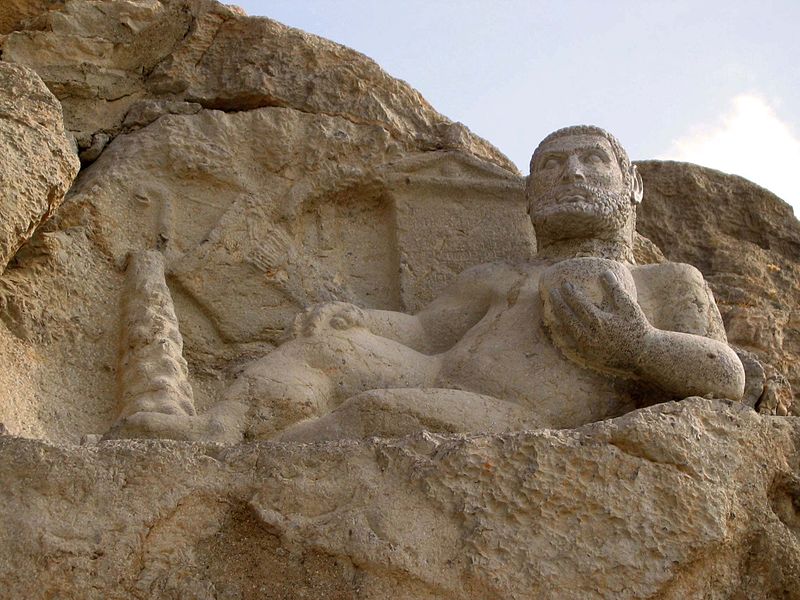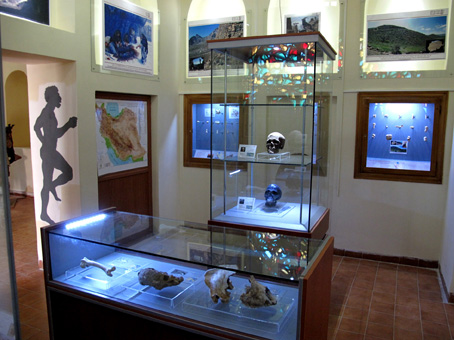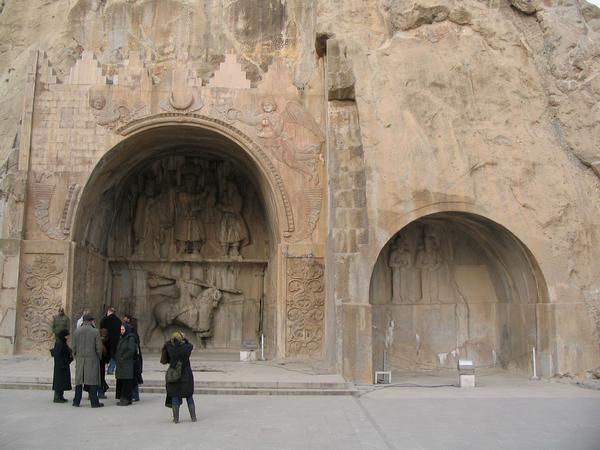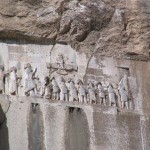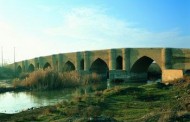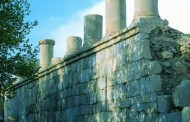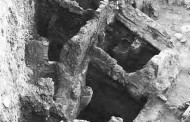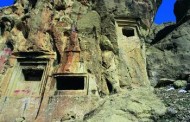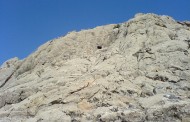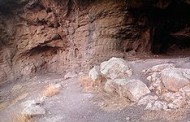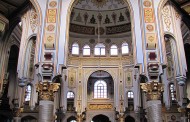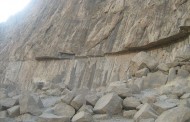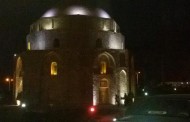Kermanshah (Persian: Kirmānshāh; also known as Bakhtaran, Bākhtarān, Kermānshāhān and Qahremānshahr), the capital of Kermanshah Province, is located 525 kilometres (326 miles) from Tehran in the western part of Iran. According to the 2011 census, its population is 851,405. People mostly speak Southern Kurdish and Persian. Kermanshah has a moderate and mountainous climate.
Because of its antiquity, attractive landscapes, rich culture and Neolithic villages, Kermanshah is considered one of the cradles of prehistoric cultures. According to archaeological surveys and excavation, the Kermanshah area has been occupied by prehistoric people since the Lower Paleolithic period, and continued to later Paleolithic periods till late Pleistocene period. The Lower Paleolithic evidence consists of some handaxes found in the Gakia area to the east of the city. The Middle Paleolithic remains have been found in the northern vicinity of the city in Tang-e Kenesht and near Taqwasan. Neanderthal Man existed in the Kermanshah region during this period. The known Paleolithic caves in this area are Warwasi, Qobeh,Malaverd and Do-Ashkaft Cave. The region was also one of the first places in which human settlements including Asiab, Qazanchi, Tappeh Sarab, Chia Jani, and Ganj-Darreh were established between 8,000-10,000 years ago. This is about the same time that the first potteries pertaining to Iran were made in Ganj-Darreh, near present-day Harsin. In May 2009, based on a research conducted by the University of Hamedan and UCL, the head of Archeology Research Center of Iran’s Cultural Heritage and Tourism Organization announced that the one of the oldest prehistorian village in the Middle East dating back to 9800 B.P., was discovered in Sahneh, located west of Kermanshah. Remains of later village occupations and early Bronze Age are found in a number of mound sites in the city itself.
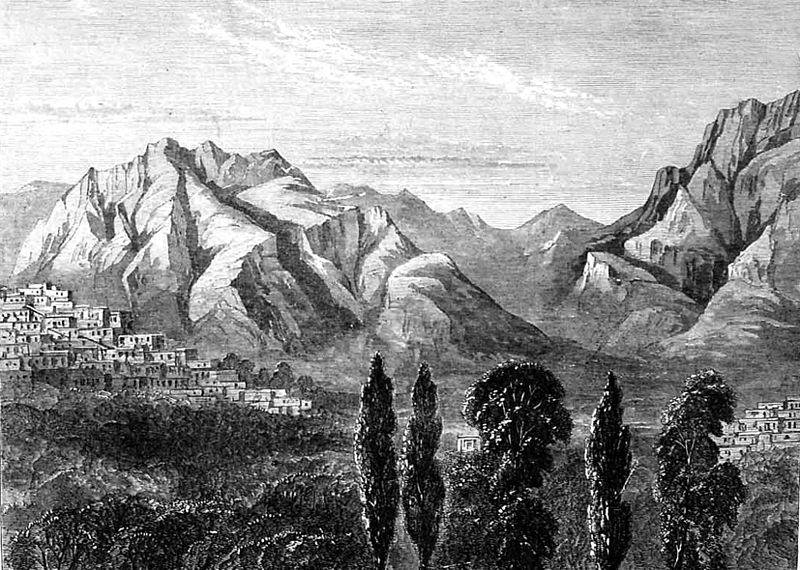
A view of Kermanshah in mid 19th century- toward south, Farokhshad Mt. and Wasi Mt. are visible at background
In ancient Iranian mythology, construction of the city is attributed to Tahmuras, the third king of Pishdadian dynasty. It is believed that the Sassanids have constructed Kermanshah and Bahram IV (he was called Kermanshah, meaning king of Kerman) gave his name to this city. It was a glorious city in Sassanid period about the 4th century AD when it became the capital city of Persian Empire and a significant health center serving as the summer resort for Sassanid kings. In AD 226, following a two-year war led by the Persian Emperor, Ardashir I, against Kurdish tribes in the region, the empire reinstated a local Kurdish prince, Kayus of Medya, to rule Kermanshah. Within the dynasty known as the House of Kayus (also Kâvusakân) remained a semi-independent Kurdish kingdom lasting until AD 380 before Ardashir II removed the dynasty’s last ruling member.
Kermanshah was conquered by the Arabs in AD 640. Under Seljuk rule in the eleventh century, it became the major cultural and commercial center in western Iran and the southern Kurdish region as a whole. The Safavids fortified the town, and the Qajars repulsed an attack by the Ottomans during Fath Ali Shah’s rule (1797–1834). Kermanshah was occupied by Ottomans between 1723–1729 and 1731-1732.
Occupied by the Ottoman army in 1915 during World War I, it was evacuated in 1917. Kermanshah played an important role in the Iranian Constitutional Revolution during the Qajar dynasty period and the Republic Movement in Pahlavi dynasty period. The city was harshly damaged during the Iran–Iraq War, and although it was rebuilt, it has not yet fully recovered.
After the revolution in 1979, the city was named Ghahramanshahr for a short period of time, and later the name of the city as well as the province changed to Bakhtaran, apparently due to the presence of the word “Shah” in the original name. Bakhtaran means western, which refers to the location of the city and the province within Iran. After the Iran–Iraq War, however, the city was renamed Kermanshah, as it resonated more with the desire of its residents, the Persian literature, and the collective memory of the Iranians.
Attractions
Kermanshah sights include Kohneh Bridge, Behistun Inscription, Taghbostan, Temple of Anahita, Dinavar, Ganj Dareh, Essaqwand Rock Tombs, Sorkh Deh chamber tomb, Malek Tomb, Hulwan, Median dakhmeh (Darbad, Sahneh), Parav cave, Do-Ashkaft Cave, Tekyeh Moavenalmolk, Dokan Davood Inscription, Sar Pol-e-Zahab, Tagh e gara, Patagh pass, Sarab Niloufar, Ghoori Ghale Cave, Khaja Barookh’s House, Chiyajani Tappe, Statue of Herakles in Behistun complex, Emad al doleh Mosque, Tekyeh-e Beglarbagi, Hunters cave, Jamé Mosque of Kermanshah, Godin Tepe, Bas relief of Gotarzes II of Parthia, and Anobanini bas relief.
- Jame-Shafeie Mosque
- Khaja Barookh’s House
- Bisotun
- Anahita on the left as the patron yazata of the Sassanian dynasty behind Emperor Khosrau Parviz with Ahura Mazda presenting the diadem of sovereignty on the right. Taq-e Bostan.
TOP SIGHTS IN KERMANSHAH
Kohneh Bridge
Kohneh Bridge (Persian: Pol-e-Kohneh) is a bridge across the river Qaresoo in the eastern suburb of Kermanshah city in Iran. It is near the village... Read more
Taq Bostan
Taq wa San or Taq-e Bostan (Kurdish:, “arch of stone”)(Persian: “arch of the garden”) is a site with a series of large rock r... Read more
Temple of Anahita at Kangavar
The Anahita Temple is the name of one of two archaeological sites in Iran popularly thought to have been attributed to the ancient deity Anahita. The... Read more
Ganj Dareh
Ganj Dareh, “Treasure Valley” in Persian, or “Treasure Valley Hill” if tepe/tappeh (hill) is appended to the name) is a Neolit... Read more
Essaqwand Rock Tombs
The Essaqwand Rock Tombs are three rock-hewn tombs located 25 km southwest of Harsin in Kermanshah Province, Iran. On top of the middle tomb there is... Read more
Sorkh Deh chamber tomb
Sorkh Deh chamber tomb is a Shaft and chamber tomb type grave located in Kermanshah Province in Iran. Sorkh Deh in Persian means Red Village. The grav... Read more
Malek Tomb
Malek Tomb is a tower-like, octagonal, probably Ilkhanid tomb located on a hill in the center of Sonqor Town in Kermanshah Province, Iran. The top par... Read more
Do-Ashkaft Cave
The Do-Ashkaft Cave, being the Middle Paleolithic cave site, is located at north of Kermanshah, near Taq-e Bostan. It is located about 1600 metres abo... Read more
Godin Tepe
Godin Tepe is an archaeological site in western Iran, situated in the valley of Kangavar in Kermanshah Province. Discovered in 1961, the site was exca... Read more
Zagros Paleolithic Museum
Zagros Paleolithic Museum is a museum in Kermanshah, Iran, established in 2008. The museum contains a large collection of stone tools and animal foss... Read more
Shafei Mosque
Shafei Mosque is the mosque of Sunni in Kermanshah , Iran. The mosque was built in 1945 . It was constructed in the style of Turkish mosques. Read more
Relief of Ardashir II
The Relief of Ardashir II is a rock relief at Taq Bostan site , in Kermanshah , Iran. The first Taq-e Bostan relief (Taq-i Bustan I), and apparently t... Read more
Shapur II and Shapur III Inscriptions
Shapur II and Shapur III Inscriptions are two Pahlavi inscriptions at Taq Bostan site, in Kermanshah , Iran. The smaller arch or iwan (Taq-i Bustan II... Read more
Statue of Hercules
Statue of Hercules is located at Bisotun complex in Kermanshah . It was discovered around 1957. It was built in 153 BC during the time of Seleucid Emp... Read more
Anubanini bas relief
The Anubanini bas relief is a rock relief from the third millennium BC and is located in Kermanshah Province, Iran. The rock relief is believed to bel... Read more
Farhad Tarash
Farhad Tarash (also Farhad Tash or Fara Tash) is a long smoothed rock surface on the Mount Behistun . This monument belongs to the Sassanid era .Its h... Read more
